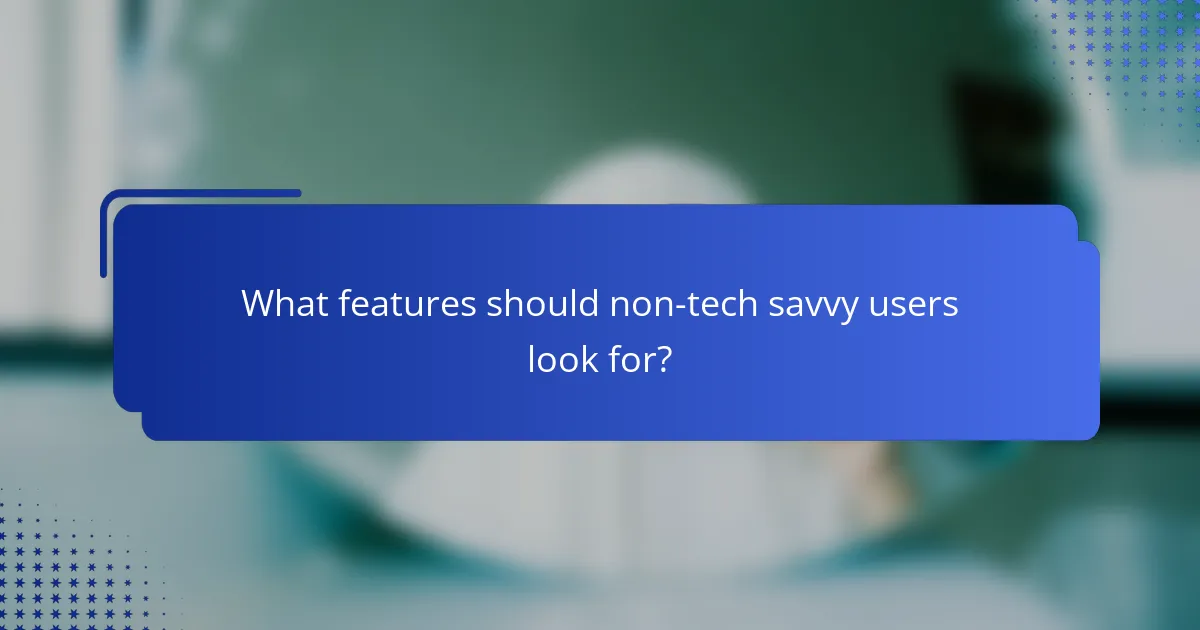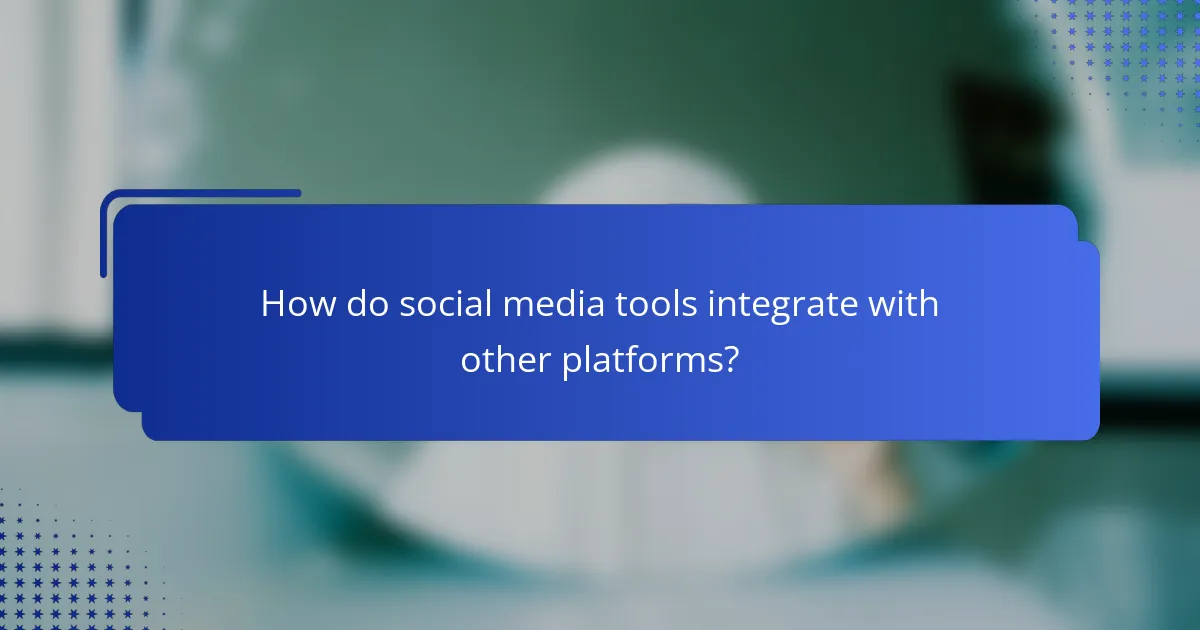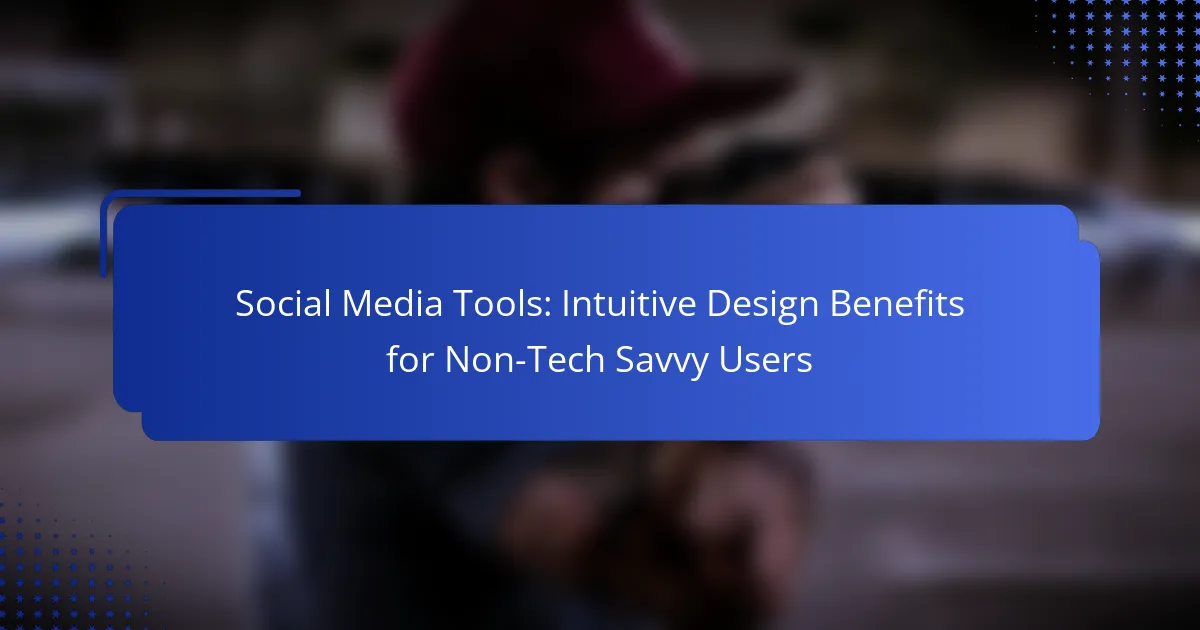In today’s digital landscape, social media tools designed with intuitive interfaces cater specifically to non-tech savvy users, allowing them to manage their online presence effortlessly. By prioritizing simplicity and clarity, these tools enable users to create, schedule, and analyze content without the need for extensive technical knowledge. Popular options like Canva, Buffer, and Hootsuite exemplify how user-friendly designs can enhance the overall experience of social media management.

What are the best social media tools for non-tech savvy users?
The best social media tools for non-tech savvy users are designed to be user-friendly and intuitive, making it easy to create, schedule, and manage content without technical expertise. Tools like Canva, Buffer, Hootsuite, and Later provide straightforward interfaces and helpful features that simplify social media management.
Canva for social media design
Canva is an accessible graphic design tool that allows users to create visually appealing social media posts without needing advanced design skills. It offers a wide range of templates tailored for various platforms, enabling users to customize images, fonts, and colors easily.
To get started, simply select a template, drag and drop elements, and export your design in the desired format. This process can take just a few minutes, making it a quick solution for creating engaging content.
Buffer for scheduling posts
Buffer is a scheduling tool that helps users plan and publish social media posts across multiple platforms at optimal times. Its straightforward interface allows users to queue posts and analyze engagement metrics without requiring technical knowledge.
To maximize effectiveness, consider scheduling posts during peak engagement times, which can vary by platform. Buffer’s analytics can help identify when your audience is most active, ensuring your content reaches them effectively.
Hootsuite for managing multiple accounts
Hootsuite is a comprehensive social media management platform that enables users to manage multiple accounts from a single dashboard. This tool is particularly beneficial for individuals or businesses with a presence on several social networks.
Users can monitor feeds, schedule posts, and engage with followers all in one place. To avoid feeling overwhelmed, start with a few key accounts and gradually expand as you become more comfortable with the platform’s features.
Later for visual content planning
Later is a visual content planning tool that focuses on Instagram but also supports other platforms. It allows users to drag and drop images into a calendar, making it easy to visualize and organize posts ahead of time.
When using Later, consider creating a cohesive visual theme for your posts. This can enhance your brand’s identity and attract more followers. The platform’s preview feature helps ensure your feed looks polished before publishing.

How do intuitive designs enhance user experience?
Intuitive designs significantly improve user experience by making digital tools easier to navigate and interact with, especially for non-tech savvy users. These designs prioritize simplicity and clarity, enabling users to accomplish tasks quickly and efficiently without extensive training.
Simplified navigation
Simplified navigation is a key feature of intuitive design, allowing users to find what they need without confusion. Clear menus, recognizable icons, and logical layouts help guide users through the platform seamlessly. For instance, a well-structured homepage with prominent call-to-action buttons can lead users directly to their desired actions.
To enhance navigation, consider using breadcrumb trails and search functionalities. These tools help users track their location within the site and quickly access specific content, reducing frustration and improving overall satisfaction.
Visual appeal and engagement
Visual appeal plays a crucial role in engaging users and retaining their attention. Intuitive designs often incorporate appealing color schemes, consistent typography, and high-quality images that resonate with the target audience. For example, a social media tool that uses vibrant colors and relatable imagery can create an inviting atmosphere, encouraging users to explore further.
Additionally, incorporating interactive elements like animations or hover effects can enhance user engagement. However, it’s essential to strike a balance; excessive animations may distract users rather than facilitate their experience.
Reduced learning curve
Intuitive designs significantly reduce the learning curve for users, enabling them to become proficient with the tool in a shorter time. By employing familiar design patterns and straightforward functionalities, users can quickly grasp how to use the platform effectively. For instance, drag-and-drop features can simplify tasks like uploading content, making the process more accessible.
To further minimize the learning curve, consider providing tooltips or guided tours that introduce users to key features. This approach helps users feel more confident and capable, encouraging them to explore the tool’s full potential without feeling overwhelmed.

What features should non-tech savvy users look for?
Non-tech savvy users should prioritize features that simplify social media management, making it easy to create, schedule, and analyze content. Key features include intuitive interfaces, user-friendly tools, and accessible support options.
Drag-and-drop functionality
Drag-and-drop functionality allows users to easily move elements around the interface without needing technical skills. This feature simplifies tasks such as arranging images, videos, and text in posts, making the design process more intuitive.
When choosing a tool, look for platforms that offer a clear visual layout, enabling users to see changes in real-time. This can significantly reduce the time spent on content creation and enhance overall user satisfaction.
Templates for quick content creation
Templates are pre-designed layouts that help users quickly create posts without starting from scratch. They often come in various styles tailored for different platforms, ensuring that content meets specific requirements and looks professional.
Non-tech savvy users should seek tools that provide a diverse library of templates, covering various themes and occasions. This feature not only saves time but also inspires creativity, allowing users to focus on messaging rather than design intricacies.
Integrated analytics for performance tracking
Integrated analytics tools help users track the performance of their social media posts without needing advanced technical knowledge. These tools provide insights into engagement metrics, such as likes, shares, and comments, allowing users to understand what content resonates with their audience.
When evaluating social media tools, consider those that offer straightforward analytics dashboards. Look for features that highlight key metrics at a glance, enabling users to make informed decisions about future content strategies based on performance data.

How do social media tools integrate with other platforms?
Social media tools integrate with other platforms through APIs and third-party services, allowing users to streamline their workflows. This integration enables seamless sharing of content, automation of tasks, and enhanced communication across various channels.
Zapier for automation
Zapier connects different apps and automates workflows without requiring coding skills. Users can create “Zaps” that trigger actions in one app based on events in another, such as automatically posting new blog entries to social media. This can save time and reduce manual effort significantly.
For example, a user can set up a Zap to send a notification to their Slack channel every time someone comments on their Instagram post. This integration helps keep teams informed and engaged without constant monitoring.
WordPress for content sharing
WordPress allows users to easily share content across social media platforms directly from their website. With plugins, users can automate sharing new posts to platforms like Facebook and Twitter, increasing visibility and engagement with minimal effort.
Consider using plugins like Jetpack or Social Media Auto Publish, which can help schedule and manage posts efficiently. This ensures that your content reaches a wider audience without requiring manual updates each time you publish.
Mailchimp for email marketing
Mailchimp integrates with social media tools to enhance email marketing campaigns. Users can create targeted email lists based on social media engagement, allowing for personalized communication with followers and customers.
For instance, you can promote your latest blog post via an email campaign while simultaneously sharing it on social media. This dual approach maximizes reach and encourages cross-platform engagement, driving traffic back to your website.

What are the pricing models for popular social media tools?
Popular social media tools typically offer a variety of pricing models to accommodate different user needs. These models range from free plans with limited features to monthly and annual subscriptions that provide advanced functionalities.
Free plans with limited features
Many social media tools offer free plans that allow users to access basic features without any cost. These plans often include limited posting capabilities, basic analytics, and restricted access to customer support.
For instance, platforms like Hootsuite and Buffer provide free tiers that enable users to manage a small number of social media accounts. These options are ideal for individuals or small businesses just starting out.
Monthly subscriptions for advanced features
Monthly subscriptions are a popular choice for users who require more advanced features and greater flexibility. These plans typically include enhanced analytics, additional social media accounts, and priority customer support.
Prices for monthly subscriptions can vary widely, often ranging from around $10 to $100 per month, depending on the tool and the features included. This model is suitable for growing businesses that need more robust capabilities.
Annual plans for cost savings
Annual plans are often available at a discounted rate compared to monthly subscriptions, making them a cost-effective option for long-term users. By committing to a year, users can save anywhere from 10% to 20% on their overall costs.
For example, a social media tool might charge $120 for a monthly plan, but offer an annual plan for $1,200, effectively providing two months free. This model is beneficial for businesses that have stable social media needs and want to budget effectively.
